Our Verdict
You may not actually need a GTX 1080 Ti, but damn do you want one.
For
- Fastest single-GPU graphics card on the market
- Priced much better than the Titan XP
Against
- This level of performance won't come cheap
- Founders Edition blower vs. waiting for custom cards
PC Gamer's got your back
Third time's the charm? You bet it is. Dating back to the 700 series, Nvidia has followed a pattern for GPU launches. First come the high-end x80 and x70 cards, at very high prices. Then the x60 and x50 models trickle out over the coming months, and somewhere along the way will be a new uber-performant and uber-expensive Titan card. But as fast as the Titan might be in games, you really shouldn't buy one (unless money is no object and you simply have to have the fastest hardware around *cough* LPC *cough*), because inevitably the Titan will end up being challenged by an upstart. Much as the Greek gods overthrew the Titans, every generation the x80 Ti card ends up as the far better value.
That isn't to say the Titan cards suddenly become useless. The original GTX Titan featured full performance FP64 support, something Nvidia usually doesn't provide unless you buy a Quadro or Tesla card. The Titan cards have previously come with more VRAM—twice as much as the 780 Ti and 980 Ti. But this round, Nvidia is apparently pulling out all the stops, with a new 1080 Ti that eclipses the Titan X (Pascal, aka Titan XP) in pretty much every meaningful way—the card easily earns a spot in our best graphics cards guide.

CUDA core counts are the same, and with higher clockspeeds that means the 1080 Ti has more raw computational performance. The memory is also GDDR5X, dialed all the way up to 11Gbps (vs. 10Gbps on the Titan XP), and while there's technically 1GB less VRAM and a slightly narrower 352-bit bus (vs. 384-bit), the 1080 Ti still has a bit more memory bandwidth. In fact the only place where the Titan XP wins out is in VRAM quantity, but even then it's only 12GB vs. 11GB—hardly a large enough gap to worry about.
To understand how 1080 Ti ends up at these final specs, while the original GDDR5X memory could clock at up to 10Gbps, going higher resulted in more interference and noise. Over the past year, manufacturing of GDDR5X has improved and the result is that 11Gbps is now attainable. As for the 11GB, I'm pretty sure that's just Nvidia trying to appease anyone that bought the Titan XP—at least you have an extra GB of memory, right?
I have a theory about why Nvidia went all-in on the 1080 Ti, and it's pretty simple: Nvidia will not let AMD claim the top spot for consumer graphics cards with Vega, not even for a few weeks or even days. R9 290X was the last time AMD had a viable claim to beating Nvidia's best, and the 780 Ti mostly solved that problem. The 980 Ti preempted the Fury X by a few weeks and delivered about 10 percent higher performance, with more VRAM as an added bonus. Vega should be at least 40 percent faster than the Fury X, probably even 50 percent faster, which would put it ahead of the GTX 1080. So here we are, a couple months before RX Vega hits retail, and Nvidia drops the 1080 Ti bomb.
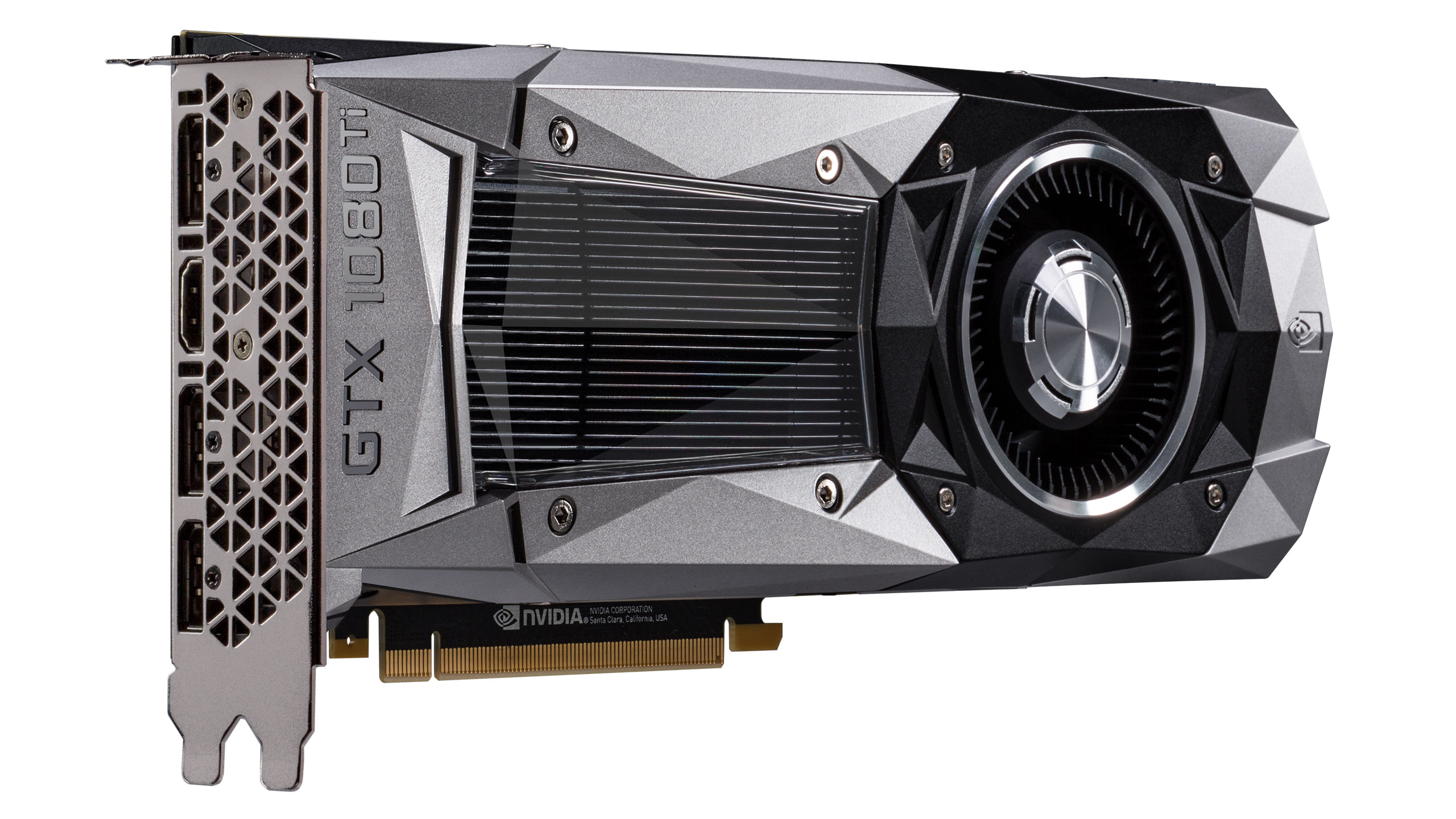
As with the prior top-shelf Ti cards, GTX 1080 Ti looks an awful lot like the Titan XP, with silver accents instead of going for an all-black cooling shroud. It also looks virtually identical to the GTX 1080 FE, except with an extra 6-pin PCIe connector and without a native DVI output. Nvidia says the actual vapor chamber is improved relative to the GTX 1080, but to the naked eye there's no visible difference.
With both the GTX 1080 Ti and Titan XP using the same GP102 GPU with 3,584 CUDA cores enabled, clock speeds play an important role. And even more importantly, Nvidia's 'typical boost clock' figures are very conservative. If you run something like Furmark or an extremely computationally intensive GPGPU workload, yeah, the typical boost clock may be around 1582MHz. In practice, even after leaving games running for several hours, the actual GPU clockspeed is often in the 1700-1800MHz range. That's using a fully stock setup. It's Nvidia's way of making customers feel like they got something extra—you'll almost always meet or exceed the 'typical boost' speed in my experience. And I have to say, I personally find this approach a lot more appealing than the 'up to' clockspeed numbers seen on other products.
The new ruler of Mount Olympus
If you want to know a bit more about what makes the GTX 1080 Ti tick, check my earlier article on the subject. The short summary: a 'secret' ingredient to Maxwell and Pascal GPUs in the form of tiled caching has helped Nvidia make better use of the available bandwidth, and the power circuitry and cooling on the 1080 Ti is improved relative to the 1080.
But I know most of you are just interested in seeing how the GTX 1080 Ti performs. For that, I present you with a full suite of sixteen games, tested at four setting/resolution combinations. I've omitted most of the older cards, since I haven't had a chance to go back and retest them with the latest drivers and game versions. For reference, the GTX 1070 tends to be roughly equal to the GTX 980 Ti, slightly faster in some cases.
Oh, and you won't find any comparisons with the Titan XP here. Why? Because I never actually got a review sample—Nvidia said the card wasn't intended for gamers, and apparently that meant not for PC Gamer either. We did some limited testing of the Titan XP last year in a Falcon Northwest Tiki, and there are two liquid-cooled Titans sitting in the LPC, but I can't really pull those out (due to the hard tubing for the liquid cooling). Sorry about that. But there's no reason to expect Titan XP will be more than a few percent slower—it's basically the more expensive fraternal twin to the 1080 Ti, and just happened to be born first.
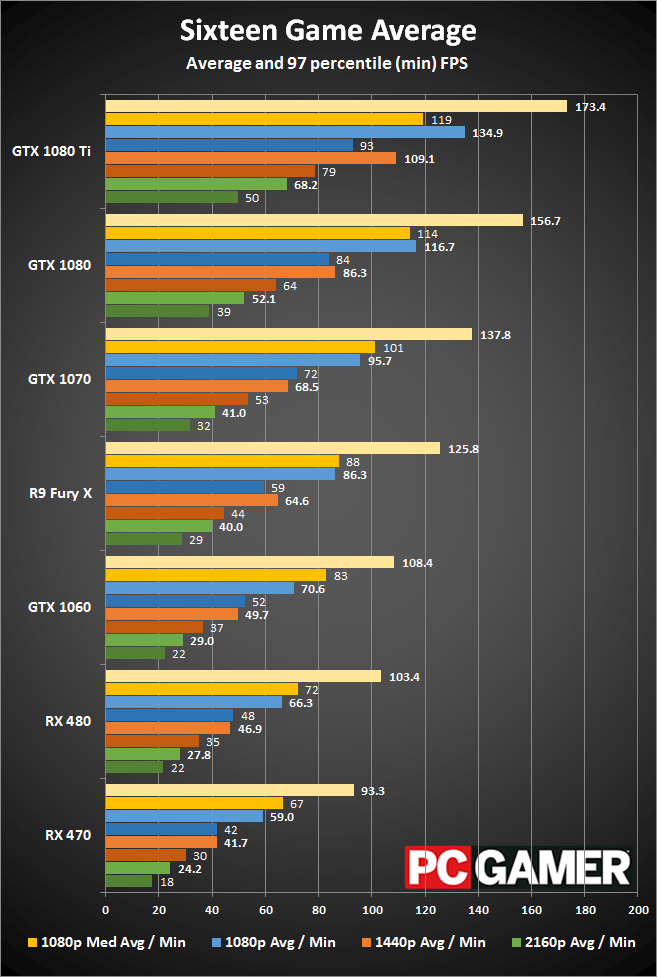
Geometric mean of sixteen games (not including Ghost Recon Wildlands). All games were tested using the best API, DX11 or DX12, for each vendor.
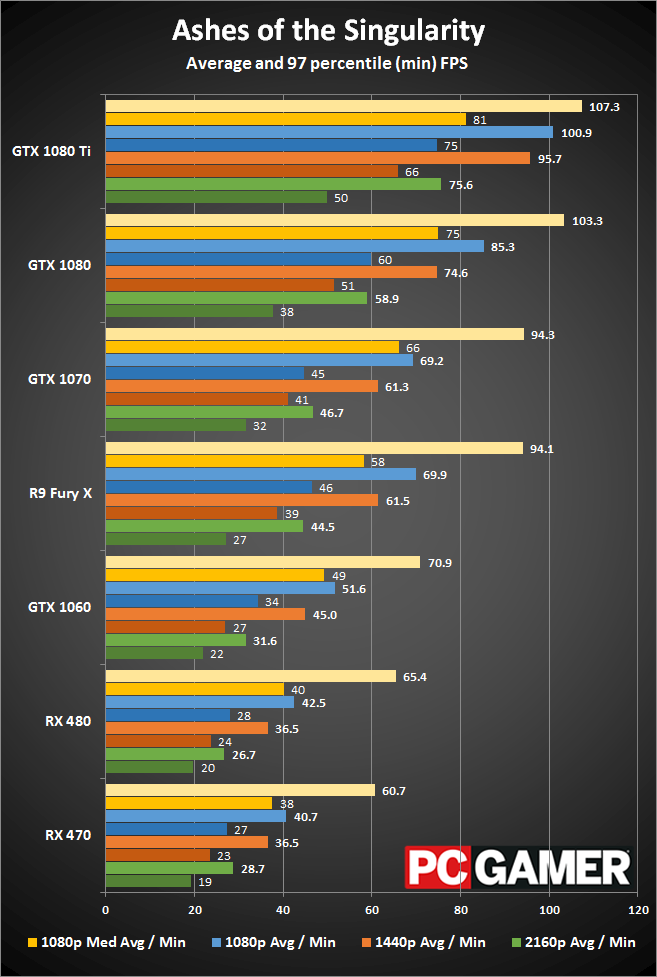
Medium uses 1080p normal preset, with extreme preset used on 1080p/1440p/4K. DX12 used for all cards.
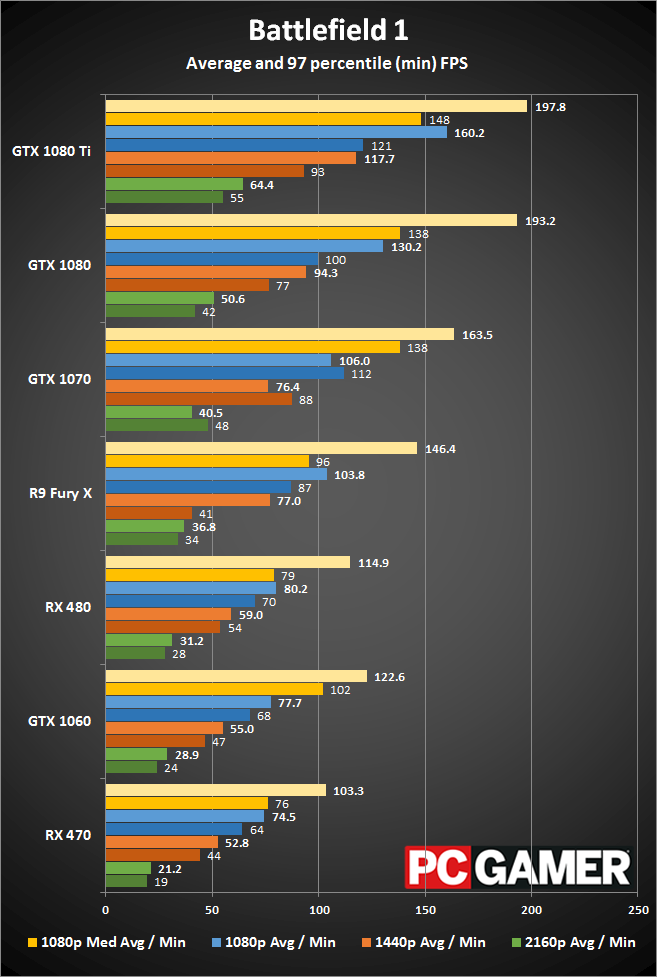
Tested with medium preset at 1080p, and ultra preset at 1080p/1440p/4K. DX12 used for AMD, DX11 for Nvidia. Note that the game has a 200 fps cap.
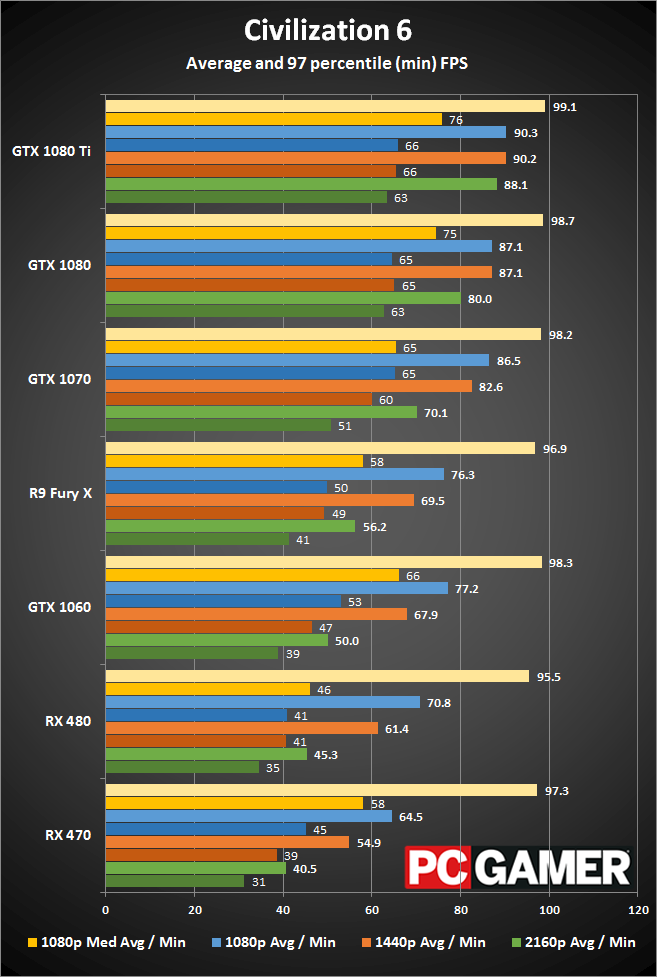
Tested with medium preset and no AA at 1080p, and ultra preset at 1080p/1440p/4K with 4xMSAA. DX12 used for all cards.

Tested with medium preset at 1080p, and very high preset at 1080p/1440p/4K with no MSAA. DX12 used for AMD, DX11 for Nvidia.

Tested with medium preset at 1080p, and ultra preset at 1080p/1440p/4K. Note that the game has a 120 fps cap.

Tested with medium preset at 1080p, ultra preset at 1080p/1440p, and high preset at 4K. DX12 used for all cards.

Tested with medium preset and FXAA at 1080p, and ultra preset with SMAA at 1080p/1440p/4K. Vulkan API used for all cards. Note that the game has a 200 fps cap.

Tested with medium preset at 1080p, and ultra preset at 1080p/1440p/4K. iPresentInterval set to 0, which results in accelerated game speed above 144 fps.
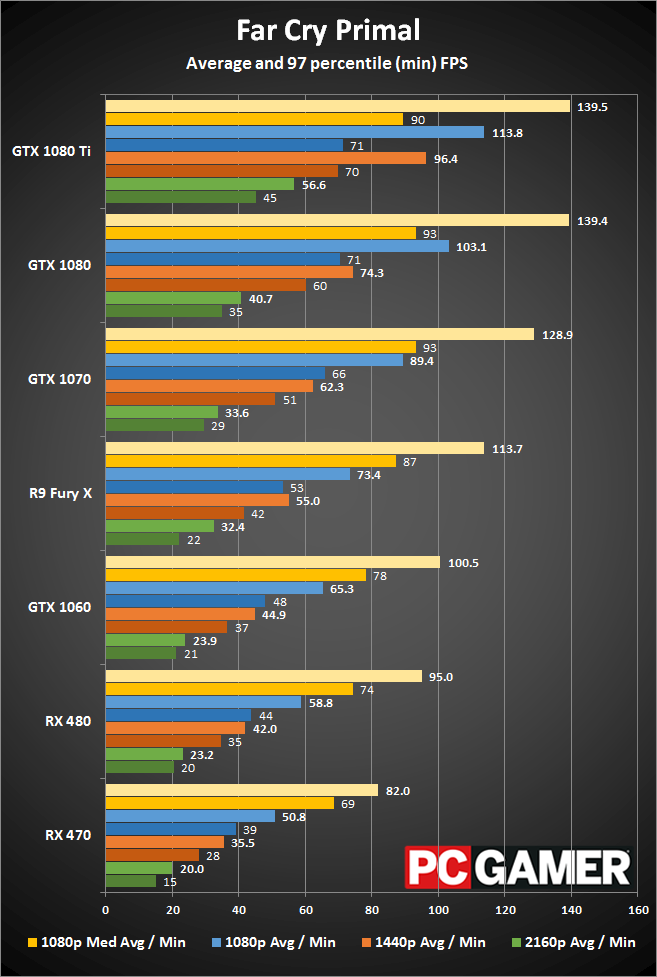
Tested with medium preset at 1080p, and ultra preset at 1080p/1440p/4K.

Tested with medium preset at 1080p, and ultra preset at 1080p/1440p/4K. DX12 / Windows 10 is required.
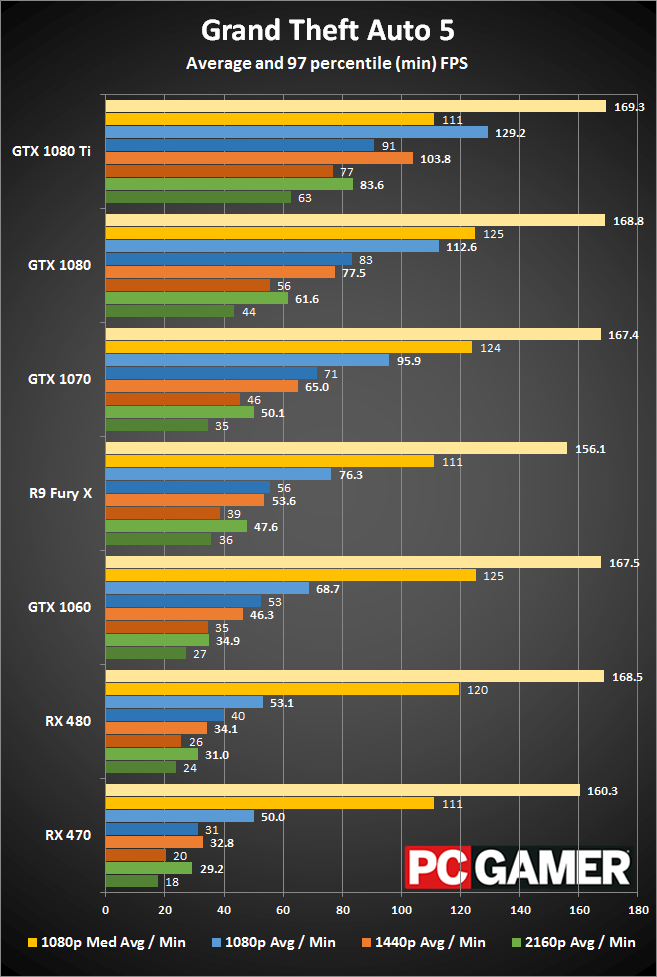
Tested with all adjustable settings on 'normal at 1080p, and all settings at max (very high / ultra) with 4xMSAA at 1080p/1440p. 4K tested without 4xMSAA.
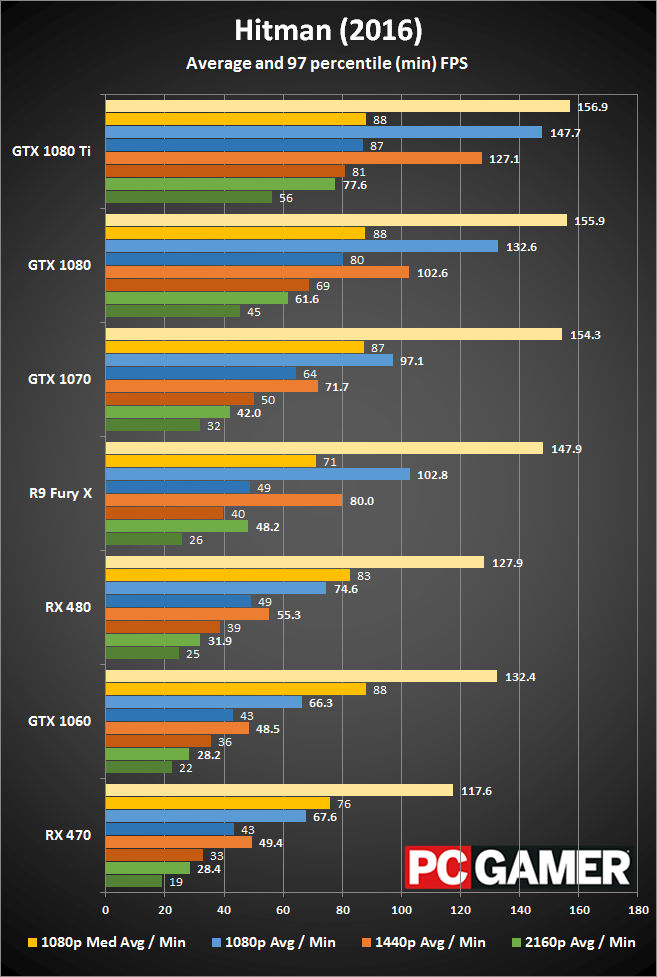
Tested with everything set to 'medium' at 1080p with FXAA, and everything at max (no SSAA) for 1080p/1440p/4K. DX12 used for all cards.
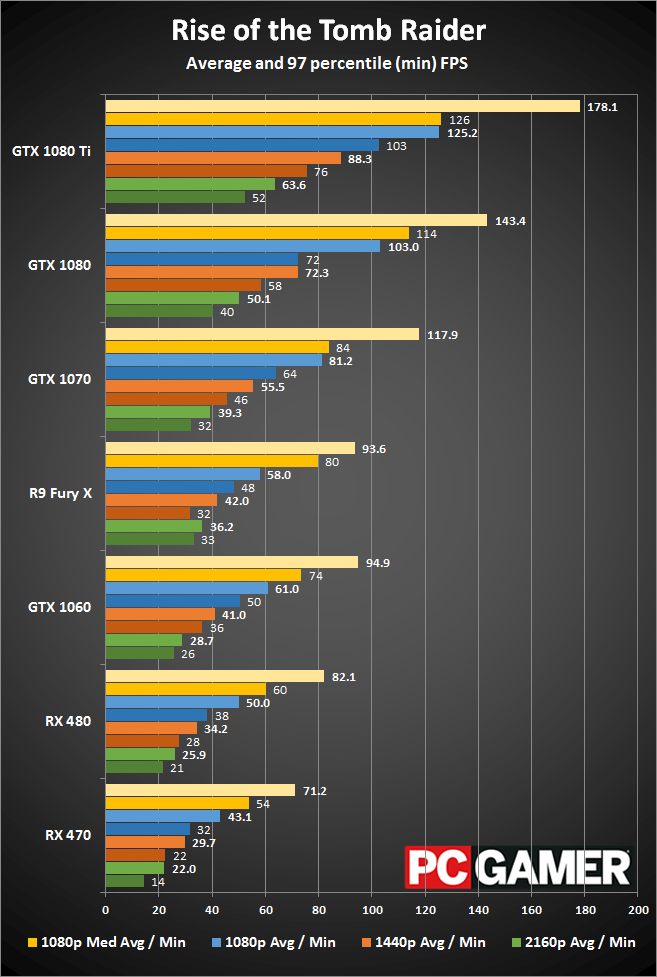
Tested with medium preset and FXAA at 1080p, very high with SMAA at 1080p/1440p, and high with FXAA at 4K. DX12 used for all cards.
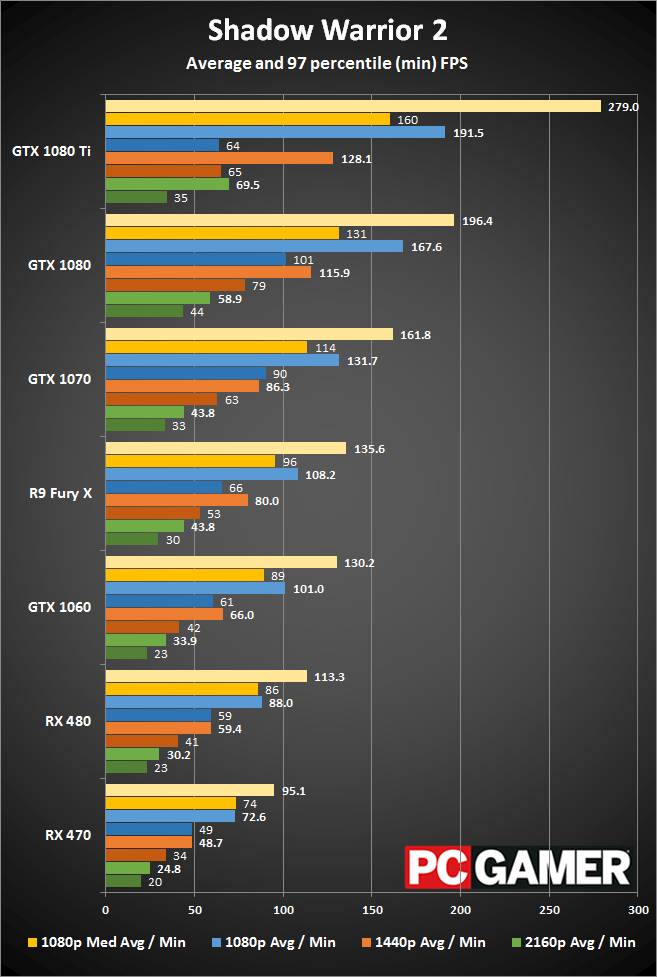
Tested with medium preset and at 1080p, and ultra preset at 1080p/1440p/4K. Note that Nvidia's current drivers have some performance anomalies on certain cards.
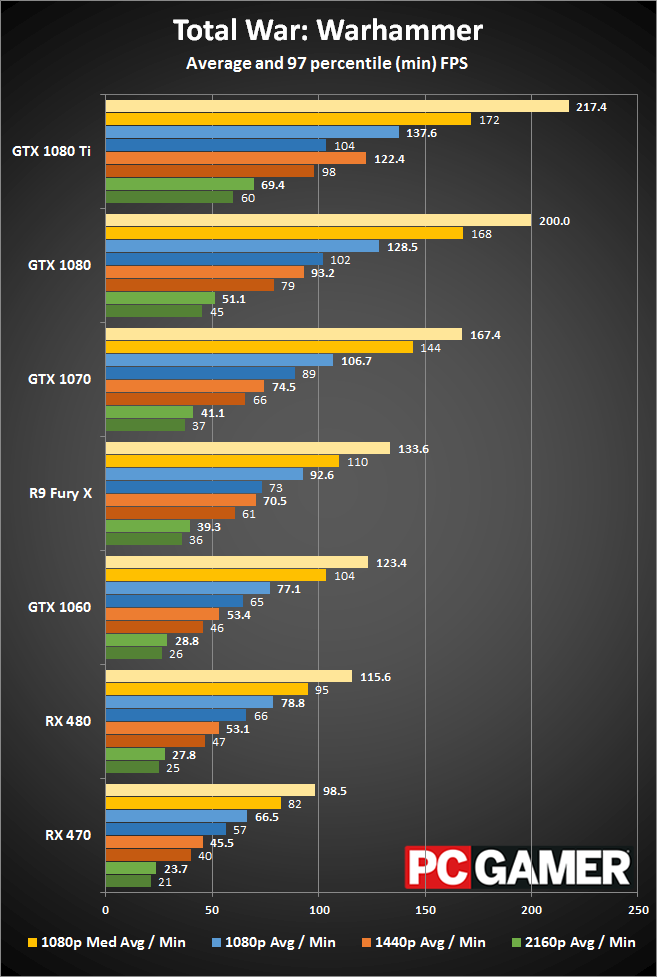
Tested with medium preset and at 1080p, and ultra preset at 1080p/1440p/4K. DX12 used for AMD, DX11 for Nvidia.

Tested with medium preset (also on post processing), and ultra preset with HairWorks disabled at 1080p/1440p/4K.
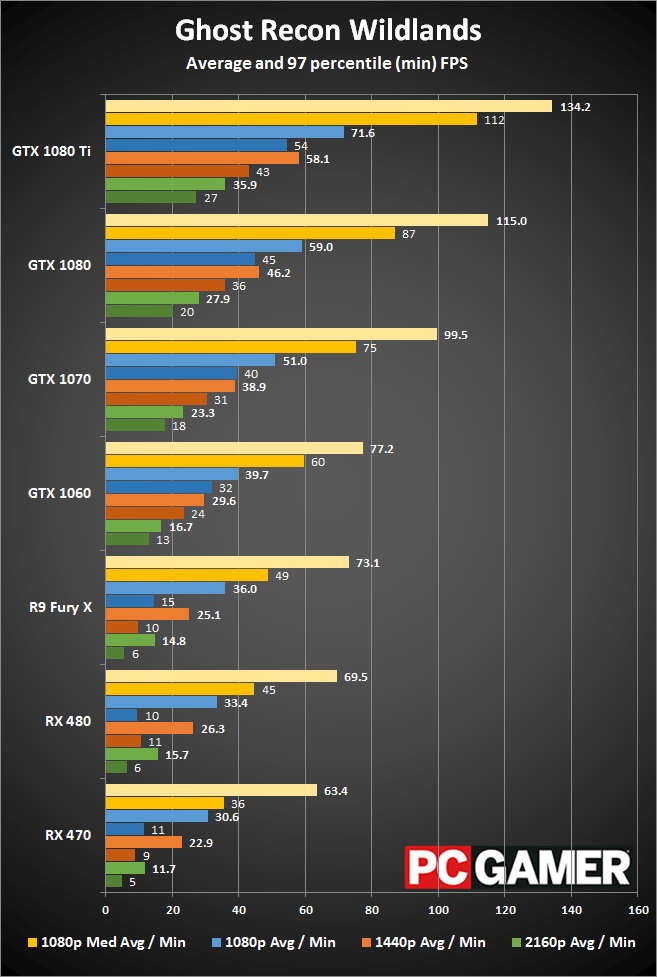
Tested with medium preset at 1080p, and ultra preset at 1080p/1440p/4K. Ultra is too much for most GPUs right now, obviously. This game was not included in the overall average score, due to its newness.
The 1080 Ti does exactly what Nvidia claimed it would: it beats the GTX 1080 by over 30 percent on average. But that's only when you're running games and settings that tax the GPU and don't hit CPU or system bottlenecks. There are a few instances where the lead is closer to 20 percent, even at 4K, and Civilization VI is still CPU limited at 4K Ultra with 4xMSAA—even 8xMSAA doesn't change things. The biggest lead comes in The Division, where the Ti is 42 percent faster.
Drop from 4K ultra (high in a few games) to 1440p ultra and the CPU and system become an even greater bottleneck. Now the Ti is only averaging about 25 percent more performance across my test suite. And at 1080p ultra the gap closes to 15 percent—not that you'd really expect anything less.
Something else to note is that of the sixteen games I tested, there are only two where AMD's current fastest graphics card, the R9 Fury X, can break into the top three, Deus Ex and Doom. Everywhere else, Nvidia lays claim to the full podium. AMD's RX Vega will hopefully shake things up a bit, and it's desperately needed.

But does that mean the 1080 Ti is capable of running any and every current game at 4K ultra settings and 60+ fps? No. Because there are still beastly games like Deus Ex, which even with the very high preset only manages 43 fps—without 4xMSAA. Another game in that same ballpark is Ghost Recon Wildlands, at least in its just-launched state, which averages just 37 fps on the 1080 Ti at 4K using the ultra preset. Update: and the new Mass Effect: Andromeda also routinely falls below 60 fps at 4K ultra.
I didn't include Wildlands in the overall average because it's still too new, and clearly there's optimization work to be done, particularly for AMD GPUs. To get above 60 fps average at 4K in the built-in benchmark, even the 1080 Ti needs to drop to the medium preset. Ouch. But most of the other games in my test suite are very close to 60 fps at 4K, and one or two small tweaks would easily push it over that threshold.
GTX 1080 Ti overclocking
With higher clockspeeds on the GPU and RAM compared to the Titan XP, you might think Nvidia pushed the card to its limits. Turns out, there's still plenty of junk in the trunk. I was able to push the GPU core up by 175MHz (though that's not a strict increase, as power limits come into play), and the GDDR5X hit 12Gbps (500MHz increase) without any apparent difficulty. With the power limit increased to 120 percent and the fan speed set at 80 percent, I saw clockspeeds right around 2000MHz, with maximum core temperatures of 70C.
What does that do for performance? Considering 1080p is mostly CPU limited, I focused on 1440p and 4K testing:
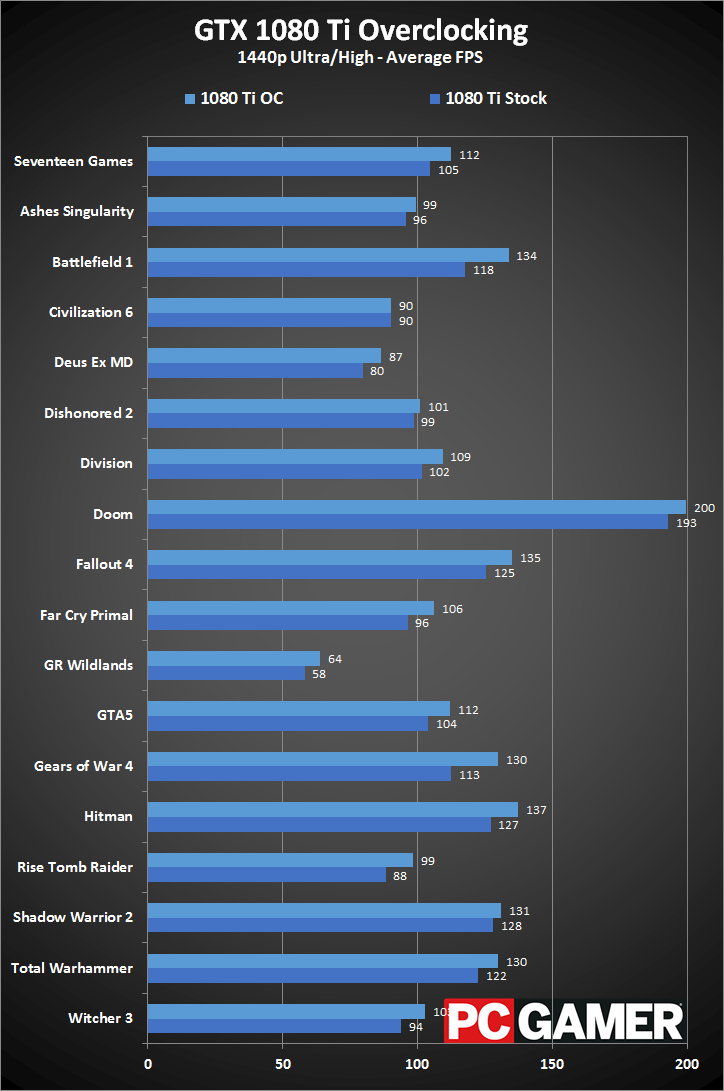
Slide left/right for 4K results.
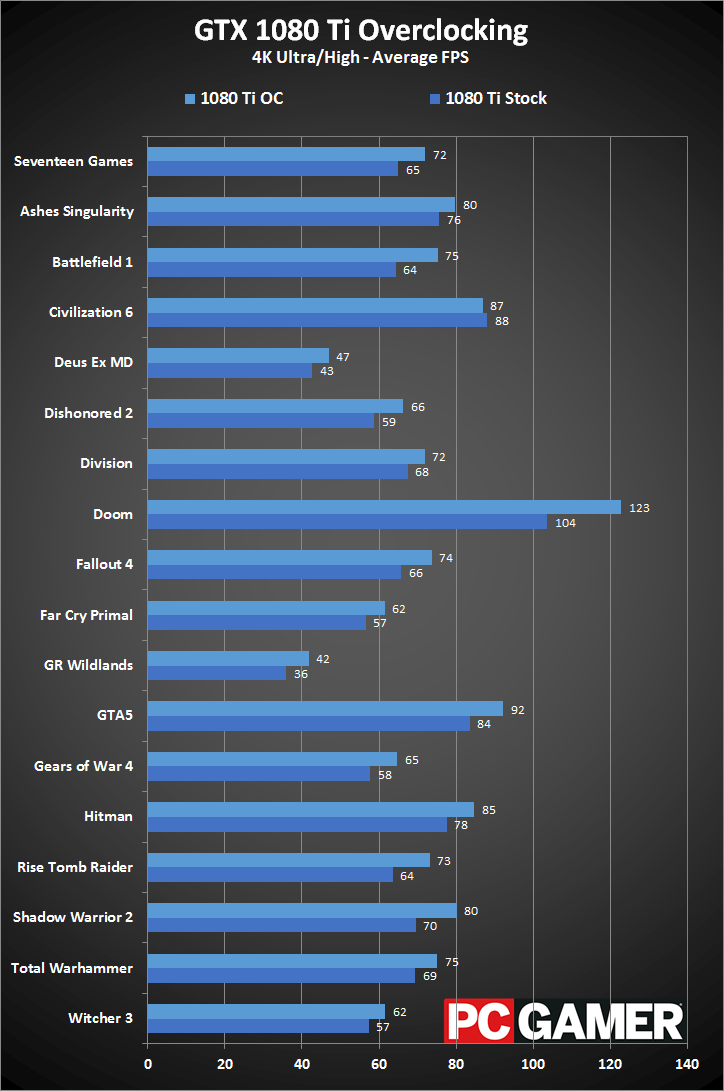
Slide left/right for 1440p results.
With core clocks about 15 percent higher and an extra 9 percent memory bandwidth, performance improves by eight percent at 1440p thanks to overclocking. 4K is more GPU limited, so the improvements are even greater—on average, 4K performance is up 10 percent. That's also enough of an improvement to put a few more games into the 60+ range at 4K ultra.
The GTX 1080 Ti routinely bumps into the power limit when overclocked, and you can achieve a decent performance improvement without touching clockspeeds if you just increase the power limit. If you're skittish about damaging a $700 GPU, raising the power limit without changing the clockspeeds is pretty much a 'free' performance boost (with a bit more power use from the graphics card).
As with the rest of the 10-series parts, 1080 Ti doesn't overclock (as a percentage) quite as much as the 900-series. Part of that is because clockspeeds already start significantly higher, but some of it is due to differences in the process technology. 16nm FinFET helps in many areas, and typical overclocks of 2GHz represent a solid 500MHz improvement over Maxwell.

The GTX 1080 Ti isn't just about raw performance, it's about retail pricing and widespread availability. Where the Titan X is a $1,200 card that's only available directly from Nvidia or through select system vendors, the GTX 1080 Ti is a $699 card and it will ship through all of the usual Nvidia graphics card partners— Asus, EVGA, Gigabyte, MSI, PNY, Zotac, and others. That means more competition, custom cooling solutions, and more variation in pricing. And while the 1080 Ti will initially launch with Founders Edition models, the Founders Edition has the same MSRP as the custom cards.
With the 1080 Ti taking over the $699 spot from the GTX 1080 FE, Nvidia has dropped prices on their other cards as well. The GTX 1080 now has a $499 MSRP, though factory OC models may still cost more. Prices have also come down on GTX 1070, with cards starting at $349 now. The 1060 and lower models don't appear to have changed in pricing, but they're in a completely different performance league.
What that means in terms of value for your money is that performance scales more in line with pricing. The 1080 Ti costs 40 percent more than the GTX 1080 and performs—in GPU limited scenarios—about 30-35 percent faster. The 1080 costs 43 percent more than the 1070 and outperforms it by about 25 percent—not perfectly linear scaling, but much better than the previous 60 percent price premium. And if you want to go further down the chain, the 1070 outperforms the 1060 6GB by about 40 percent, with a 46 percent price increase.
All of this of course depends on your chosen resolution. I've put together my usual performance vs. price charts (which ignore the cost of the rest of your system), this time with separate charts for 1080p, 1440p, and 4K. Both US and UK prices are included in the following gallery:

The GTX 1060 3GB is the theoretical best value here, but it manages only 25 fps on average at the chosen 4K settings. The 1070 is the best card to break 30 fps average on this chart.
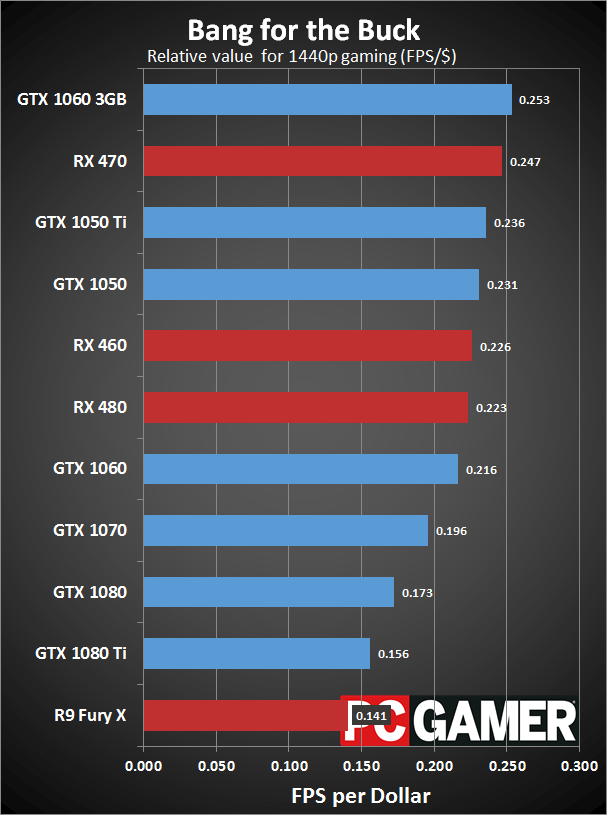
1440p at more than 30 fps is readily within reach of most of these cards. Only the GTX 1050 Ti, GTX 1050, and RX 460 fail to meet that criterion.

CPU bottlenecks prevent the fastest cards like the 1080 Ti from reaching their full potential. For 1080p gaming, even with a 144Hz display, you're usually better off with a less expensive card. An overclocked i7-7700K running at 5GHz would also help.
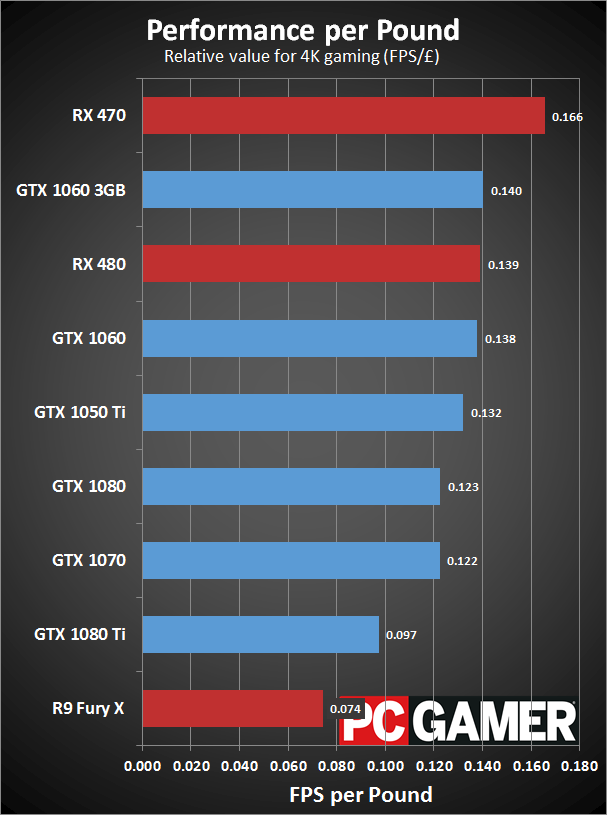
The RX 470 may top the chart, but it averages just 24 fps at the tested 4K settings. The 1070 and 1080 are closely matched for 4K value in cards that can easily break 30 fps.
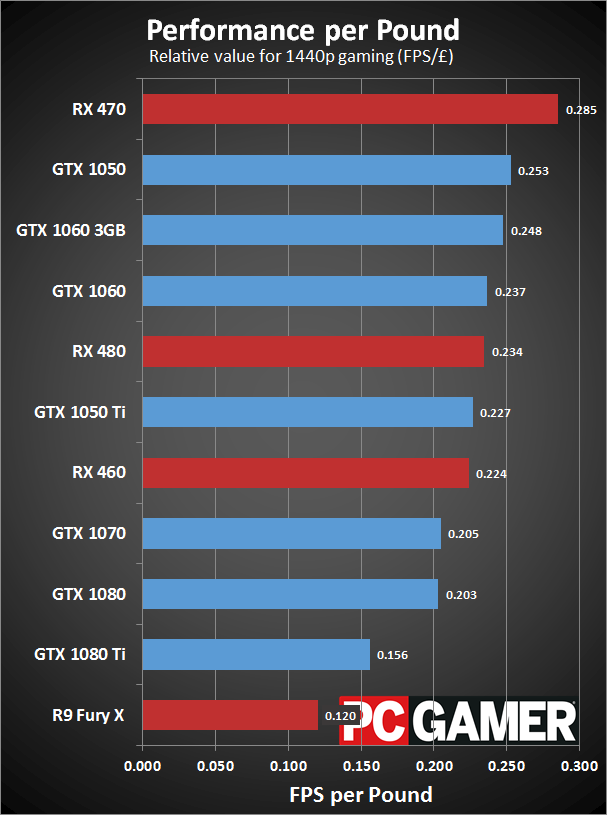
1440p at more than 30 fps is readily within reach of most of these cards. Only the GTX 1050 Ti, GTX 1050, and RX 460 fail to meet that criterion.
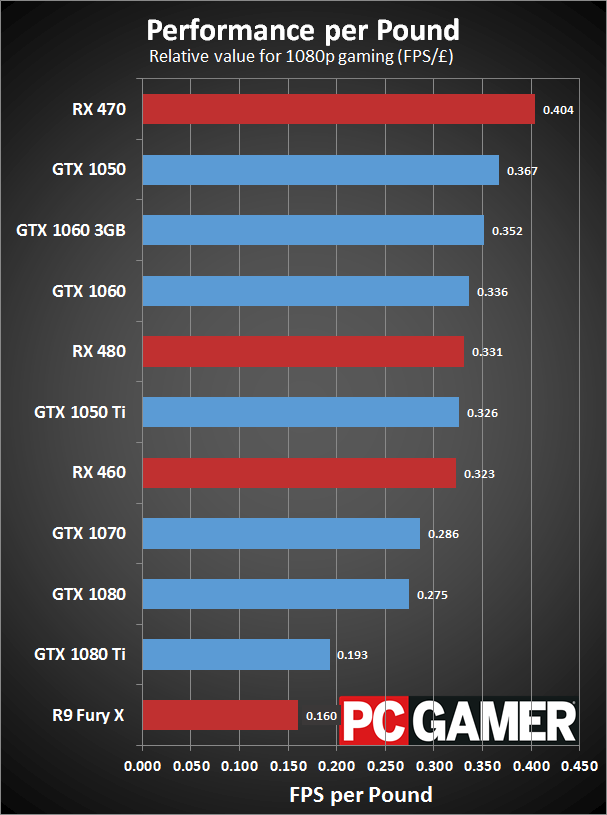
CPU bottlenecks prevent the fastest cards like the 1080 Ti from reaching their full potential. For 1080p gaming, even with a 144Hz display, you're usually better off with a less expensive card. An overclocked i7-7700K running at 5GHz would also help.
Even though scaling with price is better than before, the law of diminishing returns is still clearly in effect. For perfectly linear scaling, the above charts would be flat, but when you factor in framerates, many of the 'best' cards in terms of value come up short. If you want high resolution gaming with all the bells and whistles, my advice is you should be prepared to shell out for at least a GTX 1070. And the 1080 Ti sits near the bottom of every chart.
Obviously, there's no getting past the fact that the GTX 1080 Ti is still an extremely expensive graphics card. $700 is roughly the same price as our budget gaming PC, for example, which still includes a very capable RX 480 graphics card. This is definitely a gaming powerhouse of a graphics card, and it's designed for people that want to play 1440p 144Hz or 4K 60Hz, or even one of the upcoming 4K 120/144Hz HDR displays. If you've been holding onto an older GPU like the 780 Ti, waiting for the next high-end-but-not-Titan graphics card, it's now here.
Closing thoughts
The GTX 1080 Ti is now on sale, as of March 10. Demand is quite high, similar to the GTX 1080/1070 launch, which means it continues to sell out quickly. In the short term, we'll see some early adopter 'taxation' on the cards (aka price gouging), and depending on supply and demand, it may be a few weeks or even a month or two before the 1080 Ti is readily available at MSRP, but we'll keep an eye on things.
[Update, two weeks later: Prices remain high, as expected. Newegg currently starts at $850, while Amazon is slightly better at $800.]
If you're a computing/gaming enthusiast with deep pockets, the GTX 1080 Ti is the card to get. I couldn't quite bring myself to recommend anyone go out and buy a Titan XP—mostly because we all knew the 1080 Ti was coming, and we knew it would at least come close to Titan XP performance at a much better price. The 1080 Ti is here, and it's not just close to the Titan XP, it has specs that actually exceed the XP in several areas. With many new games failing to support SLI/CrossFire, I usually recommend getting the fastest single GPU you can afford, and 1080 Ti is the fastest single GPU right now.
If you're willing to spend $700 on graphics, the 1080 Ti is easily the best choice. Whether you actually need a card this powerful is another matter, but image fidelity is still improving and inevitably there will be cards in a few years that make the 1080 Ti look slow.
You may not actually need a GTX 1080 Ti, but damn do you want one.
Jarred's love of computers dates back to the dark ages when his dad brought home a DOS 2.3 PC and he left his C-64 behind. He eventually built his first custom PC in 1990 with a 286 12MHz, only to discover it was already woefully outdated when Wing Commander was released a few months later. He holds a BS in Computer Science from Brigham Young University and has been working as a tech journalist since 2004, writing for AnandTech, Maximum PC, and PC Gamer. From the first S3 Virge '3D decelerators' to today's GPUs, Jarred keeps up with all the latest graphics trends and is the one to ask about game performance.


